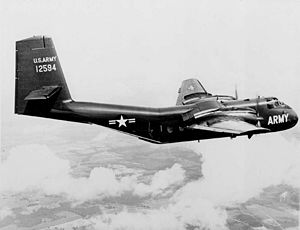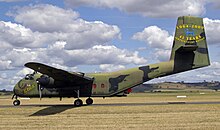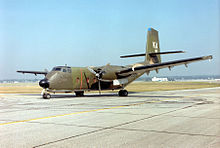de Havilland Canada DHC-4
| De Havilland Canada DHC-4 | |
|---|---|
 CV-2 Caribou of the US Army |
|
| Type: | STOL - transport aircraft |
| Design country: | |
| Manufacturer: | |
| First flight: |
July 30, 1958 |
| Commissioning: |
1961 |
| Number of pieces: |
307 |
The de Havilland Canada DHC-4 Caribou was designed as a short take-off and landing transport aircraft at De Havilland Canada . The first flight took place in July 1958. A total of 307 machines were built, of which 159 machines went to the United States Army . The aircraft was exported to many countries and sold to military and civil users.
construction
The aircraft was designed as a shoulder - wing aircraft with a positive V-position of the wings. The engines used were two Pratt & Whitney R-2000 -7M2 with 1081 kW (1450 hp) each.
The DHC-4 Caribou could carry 32 soldiers or two jeeps or a load of 3048 kg. The loading ramp could also be used by parachutists .
A special feature of this type of aircraft is that when the landing flaps are fully set, it is possible to touch down with the nose wheel only, without the main landing gear coming into contact with the ground.
variants
- CC-108 in the Royal Canadian Air Force .
- YAC-1 Designation of the first 5 test samples for the United States Army .
- AC-1 Designation for the first tranche of 56 Caribou in the United States Army. Renamed to CV-2A in 1962 .
- CV-2A designation from 1962 in the United States Army, later renamed C-7A Caribou in the United States Air Force .
- CV-2B Second tranche of 103 Caribou in the United States Army, later renamed C-7B in the United States Air Force.
- C-7A / B Designation of all 144 Caribou transferred from the United States Army to the United States Air Force.
commitment
The United States Army was supplied with the CV-2 Caribou from 1961 . The machine was used, for example, in the Vietnam War. In 1967 all DHC-4 Caribou were transferred from the United States Army to the United States Air Force. In return, the United States Army was allowed to expand its helicopter activities.
The Australian Air Force was the last user of the Caribou ; the last machines were in service with the 38th Squadron at RAAF Base Townsville until the end of 2009 . Two machines are on display in Australia, in the Australian War Memorial in Canberra and in the RAAF Museum at Point Cook, southwest of Melbourne .
Military users
-
 Australia : Royal Australian Air Force
Australia : Royal Australian Air Force
-
 Bangladesh : Air Force
Bangladesh : Air Force
-
 Costa Rica : Air Force
Costa Rica : Air Force
-
 Ghana : Ghana
Ghana : Ghana
-
 India : Indian Air Force
India : Indian Air Force
-
 Iran : Air Force
Iran : Air Force
-
 Cambodia : Air Force
Cambodia : Air Force
-
 Canada : Royal Canadian Air Force
Canada : Royal Canadian Air Force
-
 Kenya : Air Force
Kenya : Air Force
-
 Cameroon : Air Force
Cameroon : Air Force
-
 Kuwait : Air Force
Kuwait : Air Force
-
 Liberia
Liberia
-
 Malaysia : Air Force
Malaysia : Air Force
-
 Nicaragua : Air Force
Nicaragua : Air Force
-
 Oman : Royal Omani Air Force
Oman : Royal Omani Air Force
-
 Spain : Air Force
Spain : Air Force
-
 Zambia : Air Force
Zambia : Air Force
-
 South Vietnam : Air Force
South Vietnam : Air Force
-
 Sweden : Air Force
Sweden : Air Force
-
 Tanzania : Air Force
Tanzania : Air Force
-
 Thailand : Royal Thai Air Force
Thailand : Royal Thai Air Force
-
 Uganda
Uganda
-
 United Arab Emirates : Air Force
United Arab Emirates : Air Force
-
 United States
United States
-
 Vietnam (loot machines from South Vietnam ): Air Force
Vietnam (loot machines from South Vietnam ): Air Force
-
 Zaire
Zaire
Incidents
During the operation of the DHC-4 there were 84 known total losses from 1959 to November 2017. In 39 of them, 244 people were killed. Of the total losses, 37 occurred in connection with the Vietnam War .
Technical specifications
| Parameter | Data |
|---|---|
| crew | 3 |
| Passengers | Max. 32 soldiers |
| length | 22.12 m |
| span | 29.12 m |
| height | 9.65 m |
| Wing area | 84.7 m² |
| Wing extension | 10.0 |
| Empty mass | 6,577 kg |
| Max. Takeoff mass | 10,886 kg |
| drive | two Pratt & Whitney R-2000 -7M2 with 1,081 kW (1,450 PS) each |
| Top speed | 348 km / h at an altitude of 1,980 m |
| maximum permissible speed | 385 km / h (208 kn) below 3000 m (10,000 ft) |
| Minimum speed | 59 mph or 95 km / h, with flaps in landing position |
| Service ceiling | 7,559 m |
| Range | 320 km (3320 kg), 965 km (2720 kg) including reserve fuel |
Web links
Individual evidence
- ↑ Accident Statistics de Havilland Canada DHC-4 Caribou , Aviation Safety Network (English), accessed on November 24, 2017.
- ↑ MacDonald Aircraft Handbook Green 1964 , p. 249.

